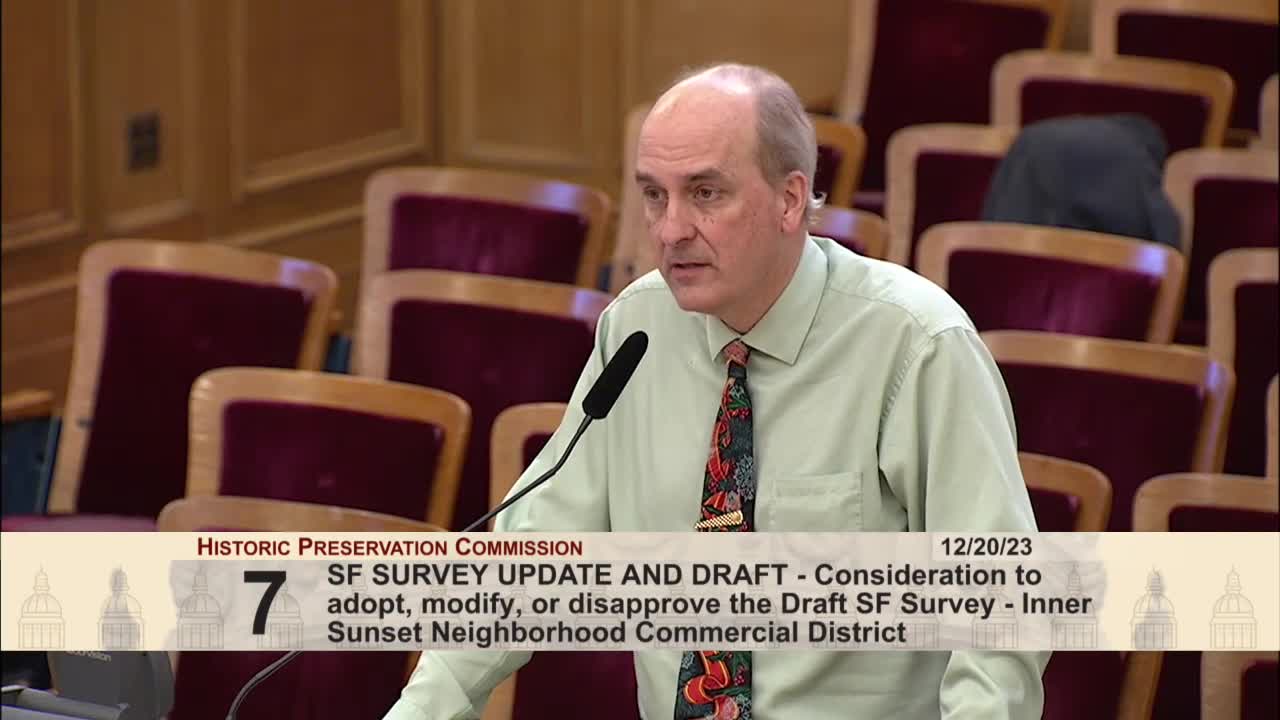Community members urge Irving Street corridor survey before major upzoning decisions
December 20, 2023 | San Francisco City, San Francisco County, California

This article was created by AI summarizing key points discussed. AI makes mistakes, so for full details and context, please refer to the video of the full meeting. Please report any errors so we can fix them. Report an error »

In a recent San Francisco government meeting, city officials and community members engaged in a significant discussion regarding the ongoing survey of historic commercial corridors, particularly focusing on Irving Street. The meeting highlighted the importance of community input in shaping urban planning decisions, especially as the city prepares for substantial upzoning in various neighborhoods.
Bridgette Maley, a community member, emphasized the need for careful consideration of the Irving Street corridor, which is set to be upzoned to 85 feet. She raised concerns about how this upzoning might affect local businesses, particularly small, unique establishments that contribute to the city's character. Maley urged the commission to ensure that community stories and feedback are integrated into the planning process, especially as similar upzoning is planned for other commercial areas like Clement and Balboa Streets.
The discussion underscored the potential impact of increased building heights on the affordability and viability of local businesses. Maley pointed out that limiting formula retail in neighborhood commercial zones is crucial for preserving the unique fabric of these areas. She called for a more thorough survey of additional corridors and the establishment of extensive historic districts to protect these vital resources.
Commissioners acknowledged the hard work of the planning and survey teams, expressing gratitude for their dedication despite budget constraints. They recognized the importance of the research conducted on these projects and the need for continued support to maintain the integrity of San Francisco's historic neighborhoods.
As the city moves forward with its urban development plans, the discussions from this meeting highlight the critical balance between growth and preservation, emphasizing the need for ongoing community engagement in shaping the future of San Francisco's neighborhoods. The commission's next steps will likely involve addressing the concerns raised and ensuring that community voices are heard in the planning process.
Bridgette Maley, a community member, emphasized the need for careful consideration of the Irving Street corridor, which is set to be upzoned to 85 feet. She raised concerns about how this upzoning might affect local businesses, particularly small, unique establishments that contribute to the city's character. Maley urged the commission to ensure that community stories and feedback are integrated into the planning process, especially as similar upzoning is planned for other commercial areas like Clement and Balboa Streets.
The discussion underscored the potential impact of increased building heights on the affordability and viability of local businesses. Maley pointed out that limiting formula retail in neighborhood commercial zones is crucial for preserving the unique fabric of these areas. She called for a more thorough survey of additional corridors and the establishment of extensive historic districts to protect these vital resources.
Commissioners acknowledged the hard work of the planning and survey teams, expressing gratitude for their dedication despite budget constraints. They recognized the importance of the research conducted on these projects and the need for continued support to maintain the integrity of San Francisco's historic neighborhoods.
As the city moves forward with its urban development plans, the discussions from this meeting highlight the critical balance between growth and preservation, emphasizing the need for ongoing community engagement in shaping the future of San Francisco's neighborhoods. The commission's next steps will likely involve addressing the concerns raised and ensuring that community voices are heard in the planning process.
View full meeting
This article is based on a recent meeting—watch the full video and explore the complete transcript for deeper insights into the discussion.
View full meeting
